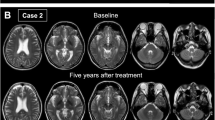Abstract
Cerebrotendinous xanthomatosis (CTX) is a rare inherited neurometabolic disease. Clinical symptoms are caused by increased deposition of cholestanol and cholesterol in various tissues. Progressive neurological symptoms are one of the principal manifestations. We report the case of a 44-year-old man who presented with asymmetric parkinsonism. In addition, there were mild bilateral pyramidal signs and a mild polyneuropathy. Brain MRI showed bilateral lesions in the dentate nucleus of the cerebellum and in the substantia nigra. Nuclear brain imaging using I-123-FP-CIT demonstrated an asymmetric reduced presynaptic dopaminergic function of the putamen and caudate nucleus, correlating well with his lateralized bradykinetic-rigid syndrome. CTX was diagnosed based on an increased plasma level of cholestanol, typical cerebellar brain lesions and the causative genetic mutation. CTX presenting with parkinsonism is considered rare and data on the neuroimaging of the dopaminergic deficit are limited.


Similar content being viewed by others
References
Gallus GN, Dotti MT, Frederico A (2006) Clinical and molecular diagnosis of cerebrotendinous xanthomatosis with a review of the mutations in the CYP27A1 gene. Neurol Sci 27:143–149
Moghadasian MH, Salen G, Frohlich JJ, Scudamore CH (2002) Cerebrotendinous xanthomatosis: a rare disease with diverse manifestations. Arch Neurol 59:527–529
Fujiyama J, Kuriyama M, Yoshidome H, Suehara M, Eiraku N et al (1991) Parkinsonism in cerebrotendinous xanthomatosis. Jpn J Med 30:189–192
Su CS, Chang WN, Huang SH, Lui CC, Pan TL et al (2010) Cerebrotendinous xanthomatosis patients with and without parkinsonism: clinical characteristics and neuroimaging findings. Mov Disord 25:452–458
de Pilo la Fuente B, Sobrido MJ, Giros M, Pozo L, Lutres M et al (2011) Usefulness of cholestanol levels in the diagnosis and follow-up of patients with cerebrotendinous xanthomatosis. Neurologia 26:397–404
Barkhof F, Verrips A, Wesseling P, van Der Knaap MS, van Engelen BG et al (2000) Cerebrotendinous xanthomatosis: the spectrum of imaging findings and the correlation with neuropathologic findings. Radiology 217:869–876
de Pilo la Fuente B, Ruiz I, de Lopez Munain A, Jimenez-Escrig A (2008) Cerebrotendinous xanthomatosis: neuropathological findings. J Neurol 255:839–842
Berginer VM, Salen G, Shefer S (1984) Long-term treatment of cerebrotendinous xanthomatosis with chenodeoxycholic acid. N Engl J Med 311:1649–1652
Acknowledgments
We wish to thank the patient for his willingness to cooperate in this study. We also wish to acknowledge the Genetic Service Facility (VIB) for the sequencing support (http://www.vibgeneticservicefacility.be/). This work was supported by the University of Antwerp, the ‘Medical Foundation Queen Elisabeth’ (GSKE) and the ‘Association Belge contre les Maladies Neuromusculaires’ (ABMM).
Conflict of interest
None.
Author information
Authors and Affiliations
Corresponding author
Rights and permissions
About this article
Cite this article
Schotsmans, K., De Cauwer, H., Baets, J. et al. Cerebrotendinous xanthomatosis presenting with asymmetric parkinsonism: a case with I-123-FP-CIT SPECT imaging. Acta Neurol Belg 112, 287–289 (2012). https://doi.org/10.1007/s13760-012-0064-7
Received:
Accepted:
Published:
Issue Date:
DOI: https://doi.org/10.1007/s13760-012-0064-7




